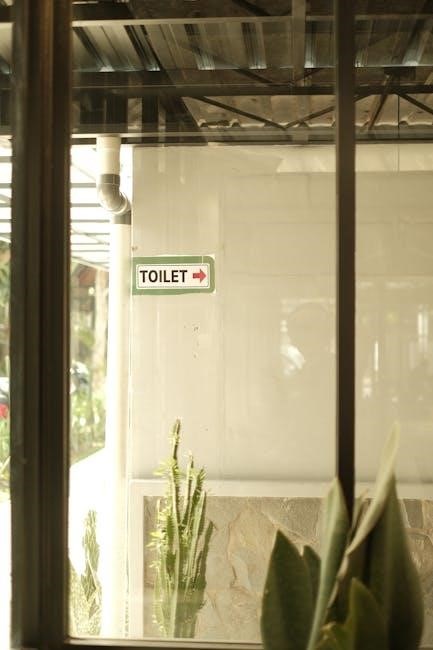window guide
Window installation is a crucial process that enhances energy efficiency‚ aesthetics‚ and functionality․ This guide provides a comprehensive overview‚ covering preparation‚ execution‚ and post-installation care․
1․1 Understanding the Basics of Window Guide
A window guide provides essential insights into selecting‚ measuring‚ and installing windows․ It helps homeowners and professionals understand types of windows‚ materials‚ and installation methods․ Key aspects include energy efficiency‚ structural integrity‚ and aesthetic considerations․ The guide also outlines tools and safety measures‚ ensuring a smooth process․ By following a window guide‚ individuals can avoid common mistakes and achieve professional results․ Proper preparation and execution are emphasized to guarantee durability and functionality․ This foundational knowledge is crucial for successful window installation projects‚ whether for new construction or replacements․
Types of Windows and Their Installation Requirements
Various window types‚ such as double-hung‚ casement‚ and sliding‚ require specific installation techniques․ Each style demands precise measurements‚ framing‚ and materials to ensure proper fitment and functionality․
2․1 Overview of Different Window Styles and Materials
Windows come in various styles such as double-hung‚ casement‚ sliding‚ and fixed․ Each style suits different architectural designs and functional needs․ Materials like vinyl‚ wood‚ aluminum‚ and fiberglass offer unique benefits․ Vinyl windows are durable and low-maintenance‚ while wood provides a classic aesthetic․ Aluminum is lightweight yet strong‚ and fiberglass combines durability with energy efficiency․ Understanding these options helps homeowners choose the best fit for their homes‚ ensuring both functionality and visual appeal․ Proper selection enhances energy efficiency and home value‚ making it a critical decision in window installation․

Tools and Materials Needed for Window Installation
Essential tools include a level‚ measuring tape‚ drills‚ screwdrivers‚ and shims․ Materials like flashing‚ insulation‚ and weatherproofing sealants ensure a secure and energy-efficient installation․
3․1 Essential Tools and Safety Precautions
Proper tools are vital for a successful window installation․ A level ensures alignment‚ while a drill and screwdriver secure the window․ Shims and weatherproofing materials prevent leaks․ Safety gear like gloves and safety glasses protect against injuries․ Always work on a sturdy ladder and ensure the area is clear of debris․ Using the right tools and following safety measures minimizes risks and ensures a professional finish; Proper preparation and adherence to safety guidelines are key to a smooth installation process․
Preparing the Opening for Window Installation
Measure and frame the opening accurately‚ ensuring it matches the window size․ Clean the area‚ check for damage‚ and level the surface before installation begins․
4․1 Measuring‚ Framing‚ and Leveling the Area
Accurate measurement is key to a successful window installation․ Measure the width and height of the opening and compare it with the window dimensions․ Use a level to ensure the area is perfectly horizontal and vertical․ If necessary‚ adjust the framing to align properly․ Double-check all measurements to avoid any discrepancies․ Proper leveling ensures the window operates smoothly and prevents future issues like air leaks or uneven fitting․ A well-prepared opening guarantees a secure and efficient installation process․

Step-by-Step Window Installation Process
Begin by removing the old window and cleaning the area․ Carefully lift and position the new window‚ ensuring proper alignment․ Secure it with fasteners and seal gaps for airtight installation․
5․1 Removing Old Windows and Installing New Ones
Start by unscrewing and carefully lifting out the old window․ Remove any remaining debris and inspect the area for damage․ Clean and prepare the frame for the new window․ Apply flashing to ensure weatherproofing․ Place the new window into the opening‚ using shims to level it․ Secure the window with fasteners‚ ensuring tight sealing․ Apply insulation around the edges for energy efficiency․ Finally‚ install any finishing trim and test the window’s functionality․ Proper installation ensures durability and optimal performance․ Follow safety guidelines to avoid damage or injury during the process․

Sealing and Insulating Windows
Proper sealing and insulation ensure energy efficiency and prevent air leaks․ Apply flashing and weatherproofing materials around the window frame‚ then insulate gaps with spray foam or weatherstripping․
6․1 Techniques for Proper Flashing and Weatherproofing
Flashing and weatherproofing are essential to prevent water infiltration and air leaks․ Start by applying a waterproof membrane around the window opening‚ ensuring it extends 6 inches beyond the frame․ Install drip edges above the window to direct water away․ Use high-quality weatherproofing tape to seal gaps between the window and surrounding walls․ Finally‚ apply exterior caulk around the perimeter for added protection․ Proper techniques ensure long-lasting durability and energy efficiency‚ safeguarding your windows from environmental elements․
Post-Installation Checks and Adjustments
Inspect for leaks‚ test window operation‚ and ensure proper alignment․ Adjust frames or hardware as needed to guarantee airtight sealing and smooth functionality․
7․1 Ensuring Proper Fitment and Functionality
Post-installation checks involve verifying the window’s fitment and functionality․ Inspect for gaps‚ ensure smooth operation of hinges and locks‚ and test weather-tightness․ Check that all features‚ like tilt or slide mechanisms‚ work seamlessly․ Proper fitment prevents air leaks and water ingress‚ enhancing energy efficiency and structural integrity․ Address any misalignment or hardware issues promptly to maintain performance․ Use tools to tighten or adjust components as needed․ A well-fitted window ensures long-term durability and optimal user satisfaction․

Maintenance and Care for Installed Windows
Regular cleaning‚ lubrication of hinges‚ and inspection for damage ensure longevity․ Address gaps with sealing products and maintain hardware functionality for optimal performance and energy efficiency․
8․1 Cleaning‚ Lubrication‚ and Repair Tips
Regular cleaning with mild detergents prevents dirt buildup․ Lubricate hinges and locks annually with silicone sprays for smooth operation․ Inspect weatherstripping and replace worn seals to maintain energy efficiency․ For minor scratches‚ use touch-up paint․ Address gaps with caulk or spray foam․ Clean glass with vinegar and water for streak-free results․ Check frames for rot or damage and repair promptly․ Store hardware in sealed bags to avoid loss․ Schedule professional inspections every 5 years for optimal performance․ These practices ensure longevity‚ functionality‚ and aesthetic appeal of your windows․
Common Mistakes to Avoid During Window Installation
Incorrect measurements‚ improper leveling‚ and insufficient sealing are frequent errors․ Ensure frames are square and plumb‚ and flashings are correctly applied to prevent water damage and air leaks․
9․1 Troubleshooting and Preventing Issues
Identifying issues early is key to successful window installation․ Common problems include air leaks‚ uneven frames‚ and water damage․ Inspect flashing and sealing for gaps․ Use level tools to ensure alignment․ Test window operation after installation․ Addressing these issues promptly prevents costly repairs․ Regular maintenance‚ such as cleaning and lubricating hinges‚ extends window longevity․ Educating homeowners on proper care can prevent future issues․ Always follow manufacturer guidelines for materials and tools to minimize risks and ensure a durable installation․ Proper planning and execution are essential for long-lasting results․
Successful window installation requires careful planning‚ precise execution‚ and regular maintenance․ By following these steps‚ homeowners can enjoy energy efficiency‚ improved aesthetics‚ and long-lasting functionality․
10․1 Summarizing Key Takeaways for Successful Window Installation
Key takeaways include precise measurement‚ proper framing‚ and leveling for a secure fit․ Ensuring weatherproofing and insulation is critical for energy efficiency․ Post-installation checks guarantee functionality and durability‚ while regular maintenance prevents issues․ Adhering to safety guidelines and using appropriate tools avoids errors․ Consulting professional guides and manufacturer instructions ensures compliance with industry standards․ By following these steps‚ homeowners achieve a seamless and lasting window installation that enhances both comfort and property value․
